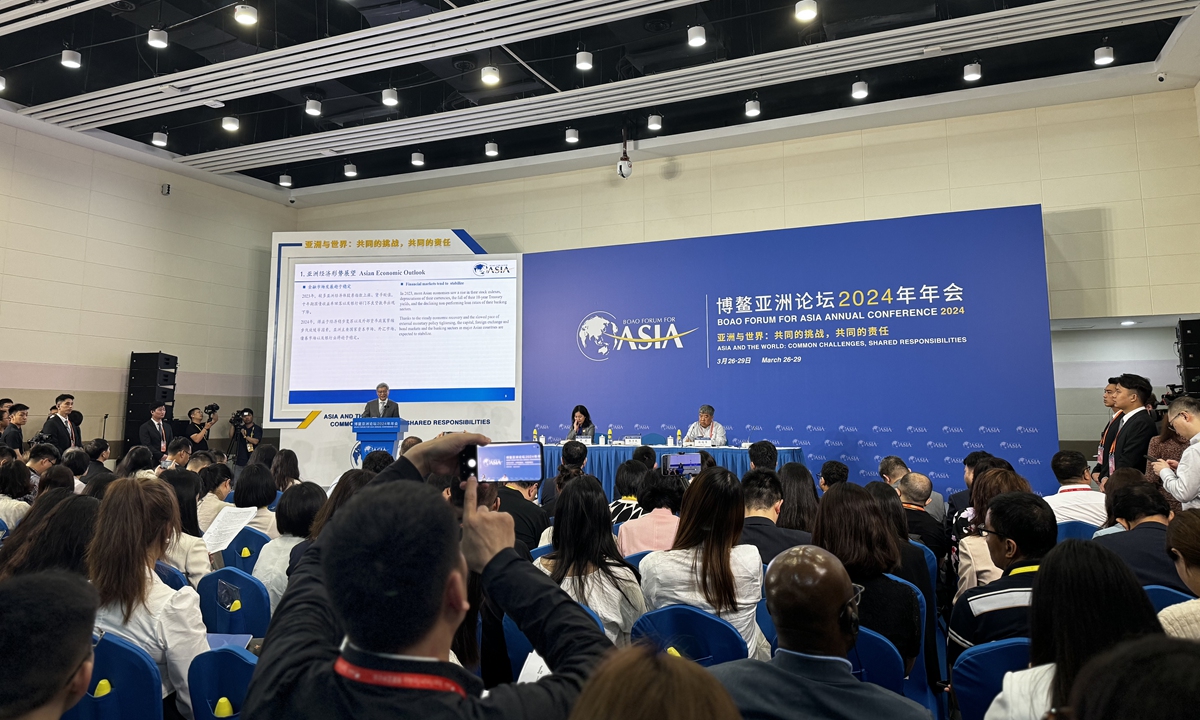
Zhang Yuyan, director of the Institute of World Economics and Politics at the Chinese Academy of Social Sciences, speaks during the ongoing Boao Forum For Asia in South China’s Hainan Province on March 26, 2024. Photo: Liu Caiyu/GT
Despite differences and uncertainties, the Asian economy is projected to sustain a strong growth rate in 2024, accounting 49 percent of the world’s GDP, and its growth rate is expected to reach 4.5 percent, continuing to be the largest contributor to global economic growth, said a report released on Tuesday during the ongoing Boao Forum For Asia in South China’s Hainan Province.The report, titled Asian Economic Outlook and Integration Progress, said facing a tough external environment and need to tackle internal challenges, the Asian economy still holds hope for a promising economic performance on the horizon.
“The momentum of Asian economic growth and regional economic integration will remain robust,” said Zhang Yuyan, director of the Institute of World Economics and Politics at the Chinese Academy of Social Sciences.
In terms of unemployment, the overall unemployment rate in Asia is expected to remain below the global average at a forecast of 4.71 percent in 2024, although the global employment outlook for 2024 is not particularly optimistic due to the ongoing economic downturn.
The report includes information about income and prices, noting that despite longer working hours for full-time jobs in many Asian countries, income growth is still facing significant challenges. Inflationary pressures in Asia are expected to decrease, although some economies with low inflation may see a slight increase in prices.
Affected by a global economic slowdown, geopolitical conflict, the still-tight international financial environment and some other factors, the growth of Asian and even global trade and investment may face greater pressures and the impact of supply chain ruptures in 2024, the report noted.
However, positive factors including the accelerated development of digital trade, the recovery of tourism in Asia, as well as the continuous advancements of some economic and trade arrangements such as the Regional Comprehensive Economic Partnership (RCEP), the positive effects of the restructuring of Asian value chains and industrial chains on regional economic integration are expected to gradually emerge, which will add new impetus to Asian trade and investment, according to the report.
As the world's largest free trade area in terms of population, economic aggregate, and trade volume in goods, the RCEP has continuously provided new institutional dividends, and promoted the vigorous development of intra-regional trade and investment and closer links between industrial and supply chains, injecting strong impetus into regional economic growth and economic integration, and making new contributions to the recovery of global economic growth.
In order to effectively promote regional economic integration and cope with the fragmentation of the world economy, the RCEP needs to further upgrade its rules and standards, expand areas of cooperation, and expand the scope of its membership.
Owing to a steady economic rebound and a deceleration in the tightening of external monetary policies, it is expected that stock indexes in most Asian economies will maintain upward trajectory, exchange rates will appreciate, while the 10-year Treasury bond yields will persist in their decline, and banking sector will see further reductions in non-performing loan ratios in 2024.
The report highlighted that Asia integration will continue. It said that based on data available in 2022, global dependence on Asian trade in goods stayed at 38.8 percent while Asian economies' reliance over Asian trade in goods remained at a high level of 57.4 percent.
Specifically, RCEP and CPTPP economies reported a trade dependence on Asia of 58.4 and 50.4 percent respectively.
China has demonstrated its notable strengths in export trade in goods, and registered a continuous growth in its exports to other economies in Asia and the Pacific. China’s exports to ASEAN and India went up by 19.2 percent and 23 percent year on year, respectively, reflecting to some extent the resilience and changes in regional value chains, according to the report. In 2024, the fast economic growth of China, ASEAN and India is projected to boost the demand for intra-regional trade in Asia.
Further, the report said due to the rise of trade protectionism worldwide, the dependence on Asia of global value chain products experienced a drop from 0.47 in 2021 to 0.43 in 2022.
Trade dependence on China, Japan and South Korea declined from 2021, but the figure in China's case was still higher than that in 2019 before the pandemic broke out, pointing to resilience and competitive edge of Factory China.
The report also revealed that in 2022, Asian economies demonstrated strong resilience in investment activities and attracted a larger share of investment from countries other than Asia.
FDI flows into Asia-Pacific economies amounted to $809.4 billion, growing by 6.76 percent over the previous year and accounting for 62 percent of international FDI inflows.
In 2022, China, Hong Kong SAR, Indonesia and Singapore directly invested more than 60 percent of their respective FDI outflows in Asia, and China remained to be the powerhouse of investment activities in the region. Meanwhile, China and ASEAN respectively received 13.02 percent and 12.04 percent of their investment inflows from within Asia, the highest ratio among all regional economies.
At the Tuesday’s conference, a report on Asia’s sustainable development was released. The report called on strengthening cooperation in green investment and financing.
Citing data provided by Asian Development Bank, between 2016 and 2030, the Asia-Pacific region will require approximately $569 billion annually for renewable energy investments from 2016 to 2030. Despite reaching a peak investment of $255 billion between 2008 and 2022, there remains a substantial annual shortfall of $313 billion in funding.
The main barriers to green investment and financing in the energy sector include policy and regulatory misalignment impacting pricing, access to finance issues due to high transaction costs and inadequate project preparation capacity, as well as reduced revenue potential from high risks and financing costs, according to the report.
